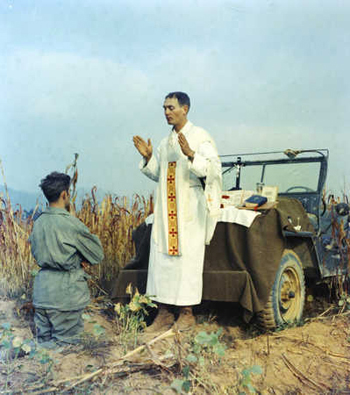YOHANCE GIBSON

One of the needs of the Diocese of Kingstown down the the Caribbean country of Saint Vincent and the Grenadines is a person trained in grant writing. Last year we identified Mr. Yohance Gibson as the person who could be trained for such a job.
One of the programs I helped implement as Director of the Saint Meinrad Institute for Priests and Presbyterates was the program outlined below. The people at Saint Meinrad were generous enough to give Mr. Yohance Gibson a full scholarship to attend this program. We are excited about the fact that Mr. Gibson has completed the onsite part of the program and the good this could mean for the whole island country of Saint Vincent and the Grenadines.

EXECUTIVE CERTIFICATE IN RELIGIOUS FUNDRAISING
The ECRF - a four-day intensive program with a practical application project - provides the research, tools and customized training to meet the growing needs of leaders in religious communities and fundraisers of faith-based organizations. The focus is on the cultural, organizational and philanthropic practices unique to religious institutions that, in turn, enable donors to experience the joy of generous giving.
Attendees include religious leaders in faith-based organizations and institutions who wish to learn more about the spirituality of fundraising and gain a core foundation in fundraising principles. Enrollment in the program is open and specifically tailored to all faith traditions. Typical attendees include clergy, laity, judicatory executives, and development leaders and professionals at faith-based organizations.
Course Description
Four one-day core courses, selected readings, online peer-group conversations, an integration paper outlining a year-long fundraising program and a final paper assessing the effectiveness of the fundraising program frame the requirements for the Executive Certificate in Religious Fundraising.
- Nurturing Generous Congregations and Organizations -This foundational course will survey the changing landscape of religious giving with a focus on its implications for faith-based fundraising. The concept of generosity will be explored as both a religious virtue and a practice, with attention given to the social and interpersonal dynamics of nurturing generosity.
Learning Objectives• Become aware of tools for assessing the level of generosity in participant's organization or congregation• Explore the socio-religious dynamics of generosity• Discover the keys to building an organizational structure nurturing generous giving• Learn how to institutionalize generosity: the role of values, beliefs, vision, mission and storytelling
Learning Tools Utilized• The Generosity Checklist• The Adaptive Leadership Model• The Hedgehog Concept - Nurturing Generous Donors - An experiential and autobiographical course focusing on the giving history and philosophy of each participant. Attention will be paid to donor profiles and donor motivations for giving. This course will also provide the fundraiser with conversational tools to use in nurturing a prospective donor through a process of discernment.Learning Objectives• Awaken development professionals and religious leaders to a spiritual way of looking at fundraising as an opportunity to nurture diverse donors and facilitate their application of generosity principles in a parish setting• Examine the metrics used to measure philanthropy while exploring the role of relationships and faith-building opportunities for donors in parish settings• Learn how to solicit gifts unapologetically and act on your personal assurance of God's abundance• Incorporate your theological tradition in a personalized approach to fundraising; integrating key stakeholders in planning; and promote discernment and adaptive leadership in discipleship developmentLearning Tools UtilizedThis seminar will be an interactive learning experience that includes a mix of instructional methods such as mini-lectures, interactive discussions, individual work and case study application.• The Giving Pyramid• The Constituency Model• Case Preparation
- Fundraising as Ministry - A practical course with an emphasis on fundraising principles, practices, tools and techniques.
Learning Objectives• Understand the difference between transactional and transformational giving• Assess your personal giving and money autobiography• Explore the relationship between religious values and generous giving• Connect the role of donor care as an extension of pastoral care• Understand the world of the donor
Learning Tools Utilized• The Philanthropic Autobiography• The Cycle of Discernment• The New Giving Paradigm - Shaping a Theology of Money - A presentation on the theology of money and giving from a Roman Catholic perspective.Learning Objectives• Have participants distinguish concepts of stewardship, philanthropy, development/advancement and fundraising while also recognizing what these have in common • Identify scriptural references that address "the meaning of money"• Explore theological principles important to "shaping a theology of money"• Expand participants' understanding of stewardship beyond "time, talent and treasure"• Help participants shape their own theology of moneyLearning Tools Utilized• Definitions exercise: stewardship, philanthropy, development/advancement and fundraising• Scripture search: Contradictory messages and muddled meaning• Shaping your own theology of money: 1) Scriptural references that speak to me
2) Theological principles that frame my work 3) Spirituality for daily living (and giving)
- Integration Paper - Upon completion of the four courses, the candidate will produce an integration paper outlining a year-round stewardship or annual giving program designed for the particular institution he or she serves. The paper is to reflect the insights of each of the four courses and outline how these practices and ideas will be integrated into the fundraising program and mission of the particular organization or congregation.
- Reflection Paper - Each participant will produce a final reflection paper in which he or she assesses: (a) his or her role and personal effectiveness in the year-long fundraising program, (b) the role of the institution in the program, (c) the way in which constituents responded to this program, (d) the promise this program holds for the ongoing financial health of the institution or congregation.





